Building a Recycling-Oriented Society
Products and Solutions that Contribute to Effective Resource Use
Resource Savings through Process Transformation at Customers
Inkjet Textile Printer Reducing Use of Water Resources
The inkjet textile printer does not require plate making or colored paste preparation that is needed with conventional screen-printing. It also contributes to the reduction of resource usage and waste, since it enables on-demand production that uses only the amount of ink and material needed. Compared to conventional screen printing, it significantly reduces environmental impact, with a 97% reduction in sizing usage, and a 62% reduction in water use.
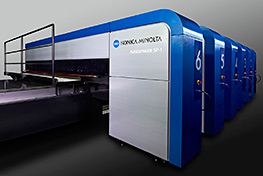
Nassenger SP-1 inkjet textile printer
In-line Pre-treatment Ink for Reactive Dyes That Streamlines the Inkjet Textile Printing Process and Reduces Chemical Usage
To ensure that reactive dye ink used in inkjet textile printing produces vivid, wash-resistant colors without bleeding into fabric fibers, a chemical pre-treatment is required to coat the fabric surface. These chemicals must be properly treated when disposed of, and the necessary equipment and associated costs place a significant burden on the textile industry.
When an inkjet textile printer is loaded with the in-line pre-treatment ink “O'ROBE,” the ink can be applied precisely—only in the necessary amount and only to the areas to be dyed—simultaneously with the reactive dye ink. This approach significantly reduces the use of pre-treatment chemicals.
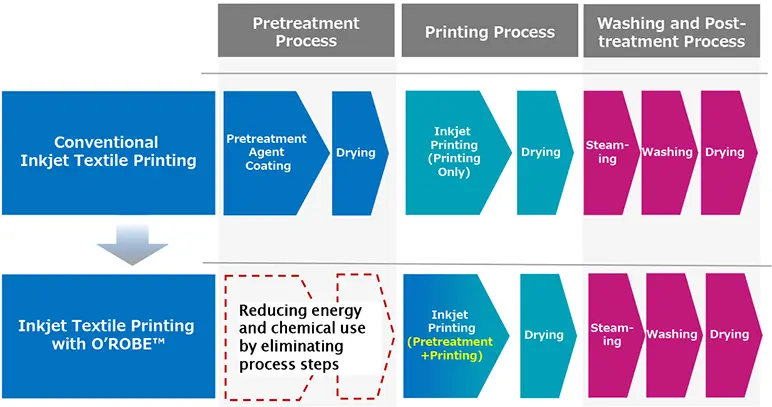
Changes in the Production Process with the Use of the In-line Pre-treatment Ink "O'ROBE"
Inkjet Press That Saves Resources During Printing
UV Inkjet Digital Press
Rising environmental awareness is driving demands for the field of commercial and publishing printing to break away from conventional methods where large amounts are printed and surplus is discarded. In the world of marketing, meanwhile, labels and packages for each event are being produced in small lots, and product and marketing strategies targeting individual consumers, such as personalized labeling with names, are gaining traction.
Konica Minolta’s digital inkjet printer AccurioJet series produces high image quality comparable to that of conventional offset printing and can handle a wide range of printing papers. It enables production of printed matter in just the quantity needed, at the time needed, to suit the customer’s exact needs. This, in turn, reduces environmental impact by minimizing waste. As one example, the printer has been equipped with ink consumption reduction mode, which helps to reduce ink waste. This solution also helps to reduce the labor-hours needed in the printing process due to its intuitive user interface that requires no specialized skills.
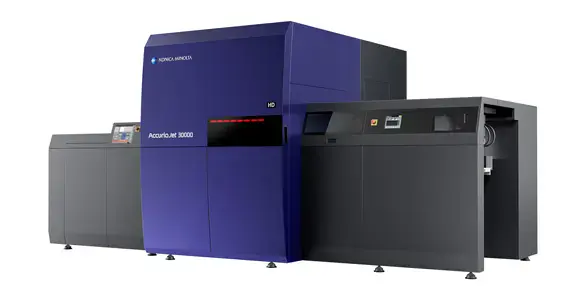
UV inkjet digital printer, AccurioJet 30000
Contributing to Resource Recycling through Sensing Technology
Konica Minolta's hyperspectral imaging, a sensing technology for multi-wavelength spectroscopic measurement of the visible to infrared light range, enables non-destructive identification of chemical substances. The technology can automate the identification of plastic materials for recycling and the inspection of foreign substances in food and pharmaceuticals, thereby helping to solve environmental problems and promote more efficient use of resources.
The appropriate sorting of each material is important when recycling plastic products. Each plastic material has its own unique reflective properties, and the SPECIM FX-17 hyperspectral camera enables the identification of PET, PP, PVC, HDPE, PS, etc. at the raw material level. The SPECIM FX-50, which is photosensitive in the long wavelength part of the infrared region, can be used to accurately sort even black plastic materials, which had been difficult until now.
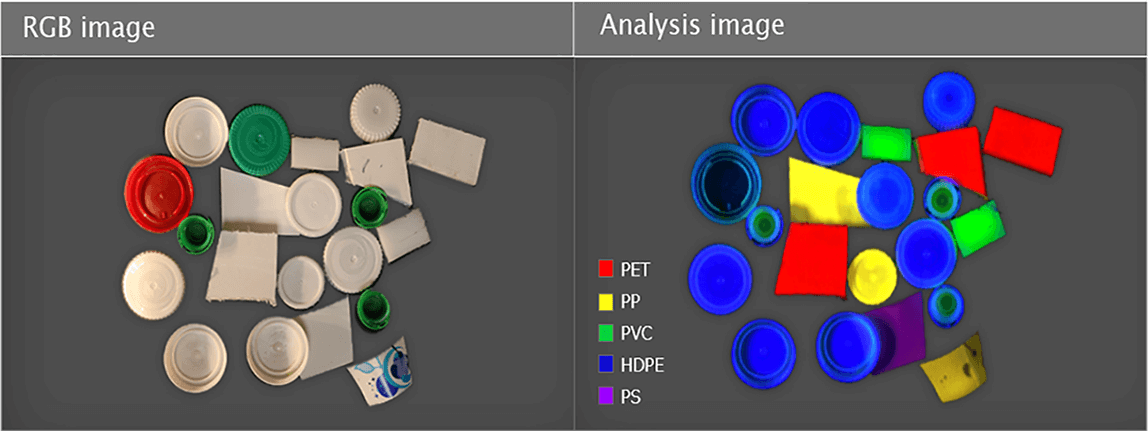
Image taken with Konica Minolta’s hyperspectral camera
Making Office Equipment Smaller and Lighter
Making products smaller and lighter contributes greatly to reducing raw materials use and energy consumption during production as well as environmental impact during disposal. Through technical development leveraging its core technologies, Konica Minolta is working at reducing the size and weight of its office equipment while increasing their performance, and is actively pursuing the development of new products with low environmental impact.
Example of product launched in 2021
The digital printing system AccurioPress C7100 offers automation, efficiency, and ease of use without the need for advanced skills on par with high-speed machines, but its width has been reduced by about 15% and its weight by about 25% compared to conventional machines.

Digital Printing System
AccurioPress C7100
Longer Product Life for Office Equipment
The process unit required for electrophotographic image formation in MFPs has a limited lifespan and must be replaced when necessary. Konica Minolta extended the lifespan of drum units, one of the shortest-life components in MFPs, by 20% in the bizhub C360i series, which incorporates a mechanism to predict the unit’s remaining lifespan. This allows the customer to replace the unit at the optimal time to prevent image defects.
Adaptation to the Circular Economy
Sales Expansion of Refurbished (Used Equipment Reconditioned) Model
Konica Minolta is implementing initiatives in Europe, Australia, and Japan to collect used multi-function devices and refurbish them for reuse by customers.
The collected multi-function devices are cleaned, checked for operation, and have their data erased, firmware updated, and in accordance with Konica Minolta’s specified standards for operation and safety. Parts are replaced with genuine Konica Minolta parts as needed. Multi-function devices that pass the final check are affixed with a "bizhub refreshed" label as proof that they meet the performance and quality standards for reliable use.
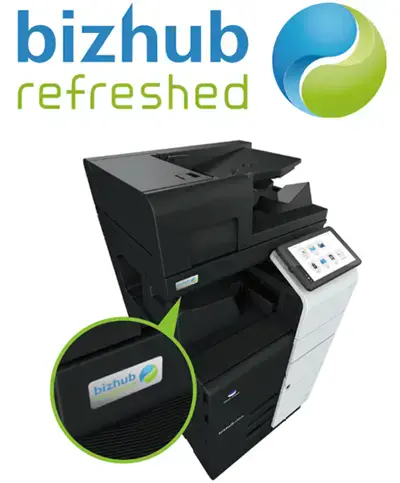
bizhub Refreshed label
Recycling Used PET Bottles and PC Gallon Bottles into an Outer Casing Material for MFPs
Konica Minolta has been striving to develop innovative technologies to recycle various kinds of plastic. In addition to transforming PET and PC plastic from beverage bottles and gallon jugs into exterior materials for MFPs, the company is also recycling ABS resin recovered from used game machines into inner casing materials. The company has developed technologies that ensure that the recycled plastic components have the necessary strength, flame resistance and molding usability. It has further advanced its chemical processing technology. For MFP products launched in fiscal 2019, the percentage of PCR* was raised to about 70% for PC/PET plastic in exterior materials and to about 95% for ABS plastic in inner casing materials. As a result, the use of recycled materials has increased to about 35% for total resin content by weight in the MFP main body.
In the successor model, the bizhub C361i series launched in 2024, Konica Minolta has maintained or exceeded the same level of recycled material usage.
* Percentage of post-consumer recycling (PCR): The percentage of material collected from the market that is used in recycled raw materials.
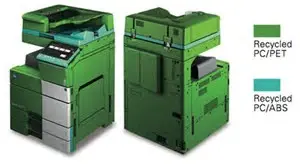
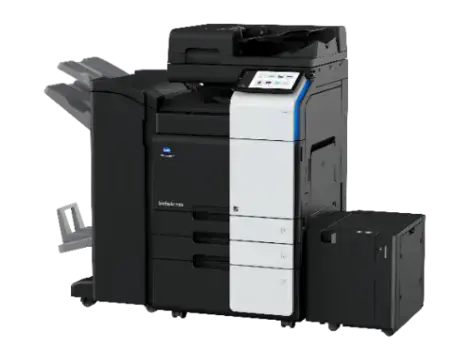
Bizhub C360i series using recycled PC/PET
Recycling Used Milk Bottles into Toner Bottles
Konica Minolta recycles milk containers made from polyethylene and turns them into toner bottles for MFPs. It developed washing technology that removes milk odor and microscopic contaminants that could compromise quality degradation and established a mass production system in Mexico and Malaysia. The company has succeeded in raising the percentage of PCR in the raw material used for toner containers to 40% and intends to increase it to 100% in the future.
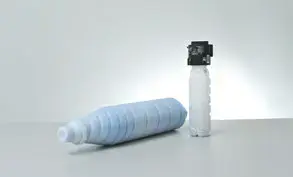
Toner bottles made from recycled material

Milk Bottle Recycling Process
Conserving Resources with Functional Materials
Making Thinner TAC* Films to Protect Liquid Crystal Polarizers
Konica Minolta has drawn on its strengths in film making technology to develop thinner TAC film, which protects polarizers in liquid crystal displays. This not only reduces the weight of IT products such as laptops and smartphones, it also reduces the materials used, thereby contributing to resource conservation.
* TAC: Abbreviation for the substance triacetylcellulose.
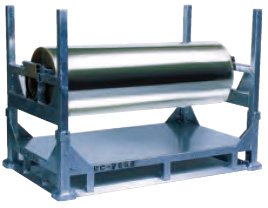
TAC film


